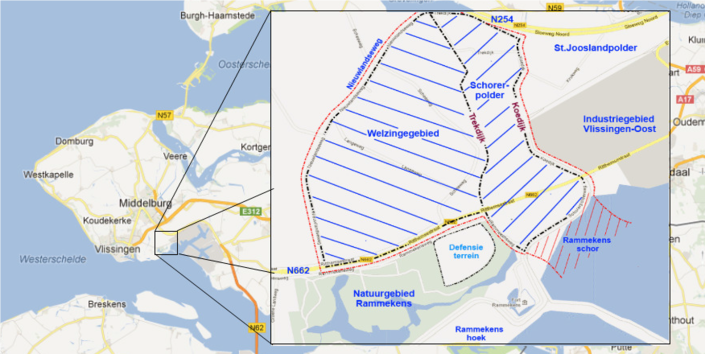Jointly understanding and validating the system and challenges
Inhoud
The area
Between the port of Vlissingen-East and the city region of Middelburg-Vlissingen lies an agricultural area including the Schorerpolder (figure 1). The owner, port authority North Sea Port, will use the polder as nature compensation for further port development. The idea is to bring the 50-hectare Schorerpolder back into contact with the sea and to create a low-dynamic, estuarine habitat which contributes to the nature objectives of the Western Scheldt estuary. This nature compensation was already discussed in 2003 for plans for a Western Scheldt Container Terminal directly outside the port, but this terminal was never realized. Now there is a plan for the construction of a new quay within the port and the nature compensation Schorerpolder is being discussed again.
Living lab
North Sea Port and nature conservation organizations united in Coalition Delta Natural are discussing the nature development in Schorerpolder. Four design variants for a future design were established through workshops and developed in terms of morphology and ecology (Tauw, 2017). However, many aspects are still unanswered. The design and use of such a new nature area requires expertise in many areas of knowledge and involvement of all parties in order to arrive at shared principles, knowledge sharing and supported choices. This is why this issue is an ideal subject for an integrated approach in which education, knowledge partners, governments, and companies work together in a very current policy area. The following three activities take place: 1. Ecosystem services Nature development Schorerpolder may provide many ecosystem services and enhance the natrual capital of the Southwestern Delta. The question is which layout of the area suits best. The four basic alternatives (TAUW, 2017) for managed realignment at Schorerpolder will be studied using the participative approach of Natural Capital Netherlands (Franken, et al., 2016, p 12-14). The research activities are:
- Quantifying potential ecosystem services for low dynamic estuarine environments, using knowledge and field observations in other estuarine environments in the Southwestern Delta (Perkpolder, Rammegors, Plan Tureluur, Waterdunen, Zwin, Hedwige etc), Belgium, Wadden region or UK. The possibilities will be explored to further increase ecosystem services by applying eco-engineering or increasing opportunities for saline cultivation. In addition, insight will be sought into the relationship between the emerging new habitat types and Natura 2000 status;
- Mapping, valuing and weighing the opportunities for ecosystem services in the Schorerpolder. This will be discussed during the workshop in June 2018 with the parties involved. The aim is to score ecosystem services within different layouts of the polder. The consequences of future Natura 2000 status of nature compensation will also be discussed in the light of future port developments.
2. stakeholder involvement
There are various methods to actively involve these stakeholders in the living lab and the co-creation process. The choice of method is coordinated with the parties involved and partly depends on the phase in which the process is situated. Based on a structured questionnaire developed by Knowledge Center Expertise and Valorisation Management (KC EVM), students will visualize what is going on, who is involved and has a mandate, what the motivation for change is, etc. Living lab work sessions will be organized in which the existing knowledge and current applied research is discussed. Participants include Zeeland Seaports, Coalition Delta Natural, Delta Academy, research partners Deltares, Wageningen Marine Research, NIOZ, companies (PORTIZ), farmers, municipalities, waterboard, citizens. and others. Important steps include:
- joint analysis of facts and figures on ecosystem services etc;
- raising awareness of each other's position;
- identifying relevant research questions;
- working towards on a shared vision.
3. Civil engineering of vital infrastructure
Many technical challenges lay ahead to adjust the existing infrastructure. To allow the tide into the Schorerpolder dikes have to be realigned, roads need to be diverted and the harbor jetty in the mouth of the port needs to be modified. New and technical sound designs have to be developed that allow sufficient exchange of seawater into the area and the development of low dynamic intertidal habitats. This include:
- come up with cost-effective designs to divert the existing dikes, taking into account failure mechanisms of the flood defenses on site;
- Measures against salinisation: the consequences of the realignment of the coastline on groundwater and freshwater supply in the surrounding agricultural land will be mapped. The usefulness and necessity of measures to combat salinisation will be investigated;
- Redesign access roads for trucks, car, and bicycle or foot area to the port and surrounding area;
- Maintenance and reinforcement of historic hard structures.
Policy frameworks
Relevant policy frameworks, including Natura2000, Ambition 2030 Zeeland Seaports, Agenda of the Future (VNSC), Natuurnetwerk Zeeland (Province of Zeeland), the national programs Delta Program on Spatial Adaptation and Flood Protection Program (HWBP).
References
- North Sea Port, Stronkhorst, HZ, 19 januari 2018.
